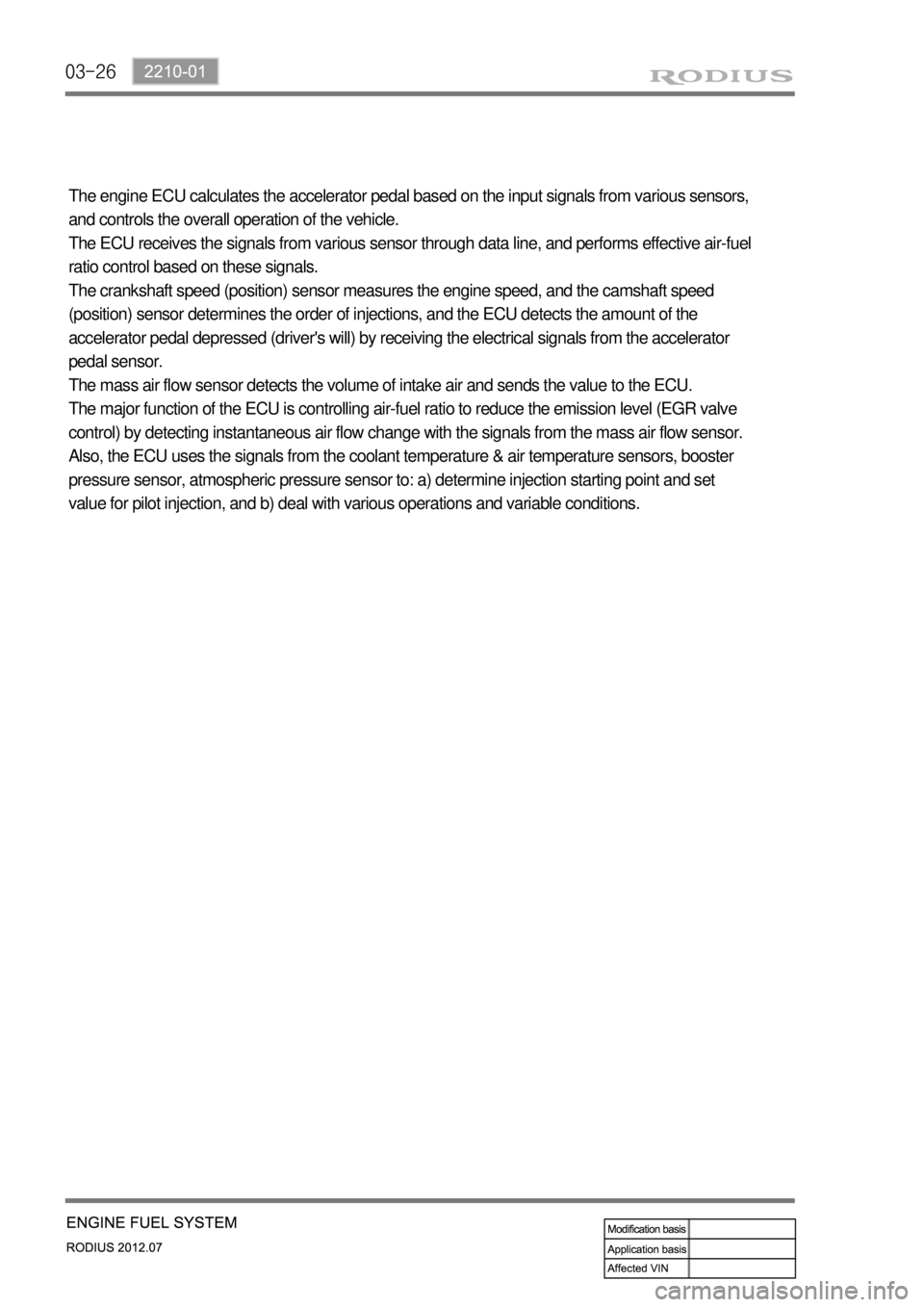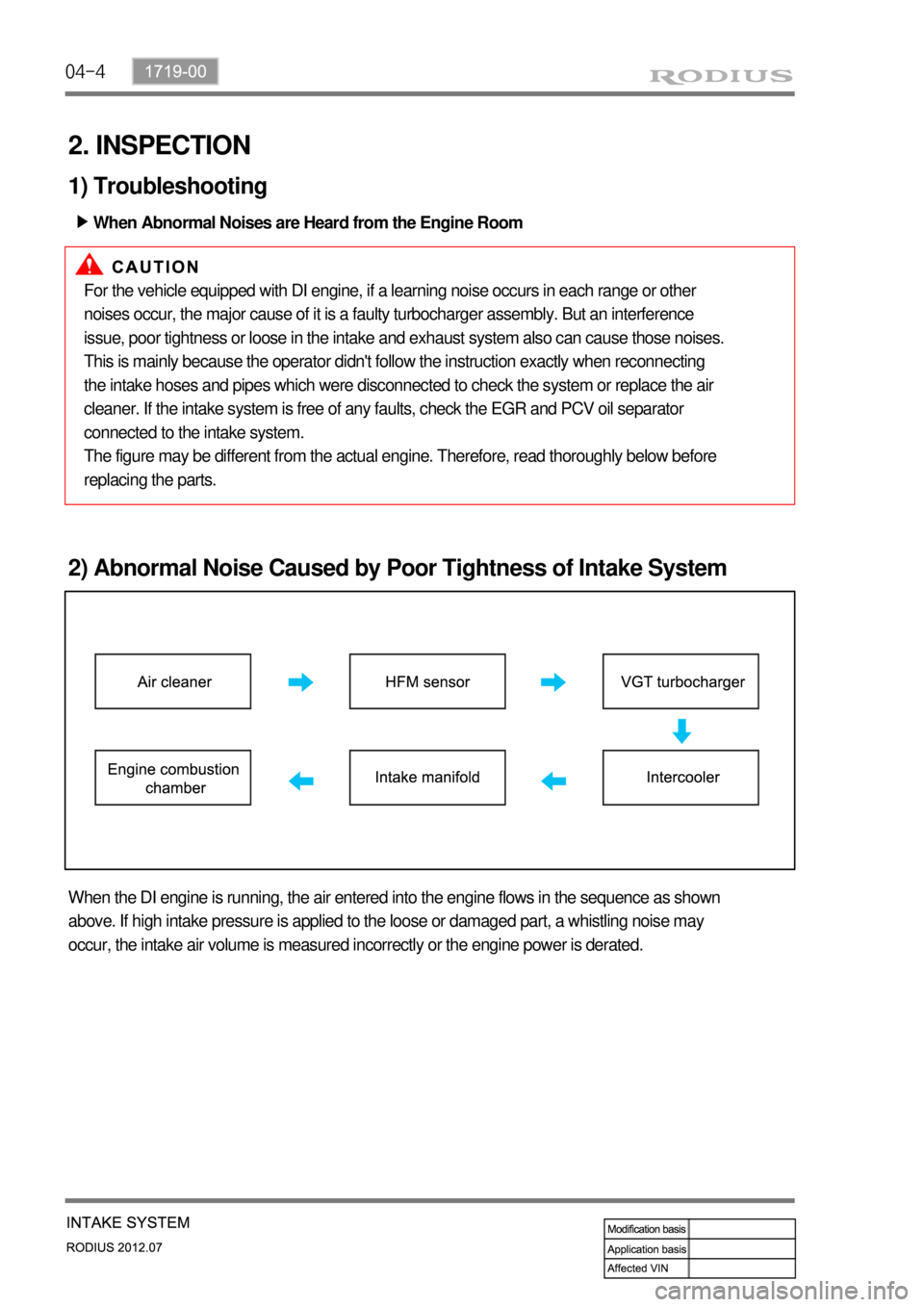Page 227 of 715
03-232210-01
T-MAP sensor
Measuring booster pressure
and temperatureFuel rail assembly
Relieving the pulsation.
Measuring the fuel pressure.
Distributing the fuel to injectors.
High pressure pump
Generating high pressurized fuel
and supplying it according to
engine rpm, required volume,
required pressure
Plunger type HP pump (1,800 bar)
Vane type LP pump (6 bar)
Accelerator pedal position
sensor
Detecting driver's intention for
speed up/down
Fuel filter assembly
Supplying clean fuel/fuel
heating/water separation by
priming pump
Page 229 of 715
03-252210-01
3) Input/Output devices
Refer to Chapter "Engine Control". *
Page 230 of 715

03-26
The engine ECU calculates the accelerator pedal based on the input signals from various sensors,
and controls the overall operation of the vehicle.
The ECU receives the signals from various sensor through data line, and performs effective air-fuel
ratio control based on these signals.
The crankshaft speed (position) sensor measures the engine speed, and the camshaft speed
(position) sensor determines the order of injections, and the ECU detects the amount of the
accelerator pedal depressed (driver's will) by receiving the electrical signals from the accelerator
pedal sensor.
The mass air flow sensor detects the volume of intake air and sends the value to the ECU.
The major function of the ECU is controlling air-fuel ratio to reduce the emission level (EGR valve
control) by detecting instantaneous air flow change with the signals from the mass air flow sensor.
Also, the ECU uses the signals from the coolant temperature & air temperature sensors, booster
pressure sensor, atmospheric pressure sensor to: a) determine injection starting point and set
value for pilot injection, and b) deal with various operations and variable conditions.
Page 232 of 715

04-4
2. INSPECTION
1) Troubleshooting
When Abnormal Noises are Heard from the Engine Room ▶
For the vehicle equipped with DI engine, if a learning noise occurs in each range or other
noises occur, the major cause of it is a faulty turbocharger assembly. But an interference
issue, poor tightness or loose in the intake and exhaust system also can cause those noises.
This is mainly because the operator didn't follow the instruction exactly when reconnecting
the intake hoses and pipes which were disconnected to check the system or replace the air
cleaner. If the intake system is free of any faults, check the EGR and PCV oil separator
connected to the intake system.
The figure may be different from the actual engine. Therefore, read thoroughly below before
replacing the parts.
2) Abnormal Noise Caused by Poor Tightness of Intake System
When the DI engine is running, the air entered into the engine flows in the sequence as shown
above. If high intake pressure is applied to the loose or damaged part, a whistling noise may
occur, the intake air volume is measured incorrectly or the engine power is derated.
Page 233 of 715
04-51719-00
3) Troubleshooting Sequence
The basic checks for intake system are as follows:
Basic Checks for Intake System ▶
Make sure to replace or clean the air cleaner
element periodically. Otherwise, engine will be
derated or work abnormally because of low
intake air volume.
Unlike the fuel system, which is a closed
circuit, the intake system is an open circuit
system. Therefore any malfunction may occur
due to dust and dirt.
Most of the connections consist of hoses so
the system cannot withstand high temperature
and pressure. Also it can be deformed or
loosened easily because it is a clamp
mounting system. Thus, when checking the
engine, basic inspections, such as tightened
status check and visual inspection for hose,
etc., should be carried out in advance.
Other Checks for Intake System ▶
If the intake system is free of any faults,
check for EGR and PCV oil separator.
Page 234 of 715
04-6
1. OVERVIEW
The intake system for D20DTR engine is equipped with a throttle body which includes a flap. This
flap is controlled by an electrical signal to cut off the intake air entering to the engine when the
ignition switch is turned off. Because of this, the shape of the intake manifold has been changed
and improved HFM sensor is newly adopted to control the intake air volume more precisely.
2. COMPONENT
2330-01 Intercooler assembly
2313-15 HFM sensor
HFM sensor, version 7
*For more information, refer to Chapter "Engine
Control".
2313-01 Air cleaner assembly
Page 235 of 715
04-71719-00
1719-01 Intake manifold
Passage for variable swirl valve and for intake
air
1719-16 Electric throttle body
* For more information, refer to Chapter
"Engine Control".
1719-02 Swirl control valve
Operating variably in accordance with the
engine load and rpm.* For more information,
refer to Chapter "Engine Control".
Page 236 of 715
04-8
3. INPUT/OUTPUT OF INTAKE SYSTEM
For more information, refer to Chapter " Engine Control". *